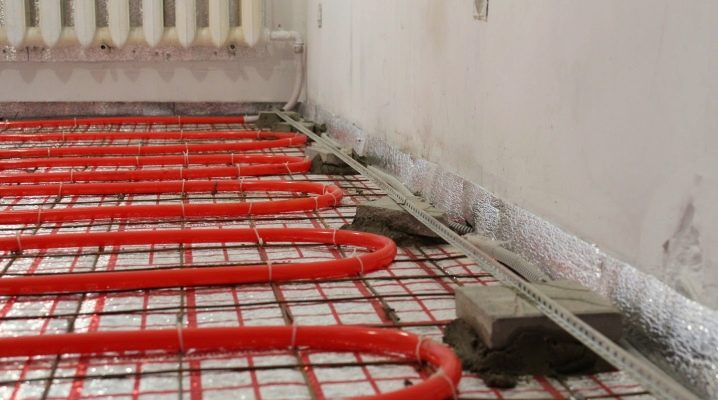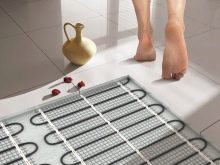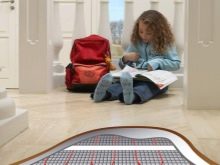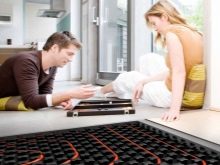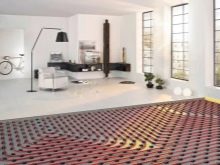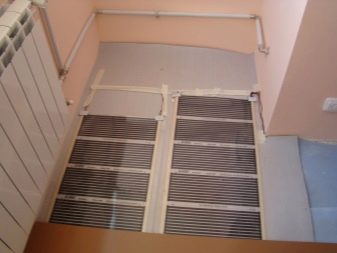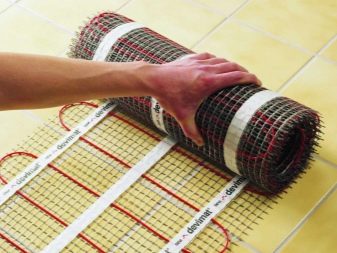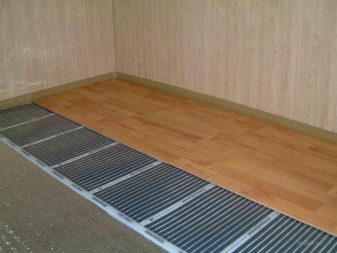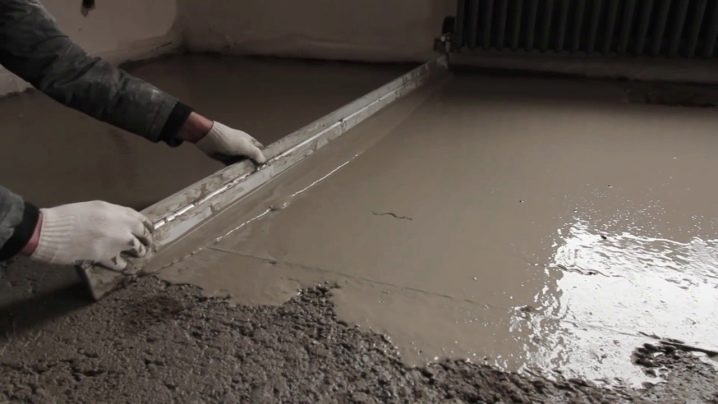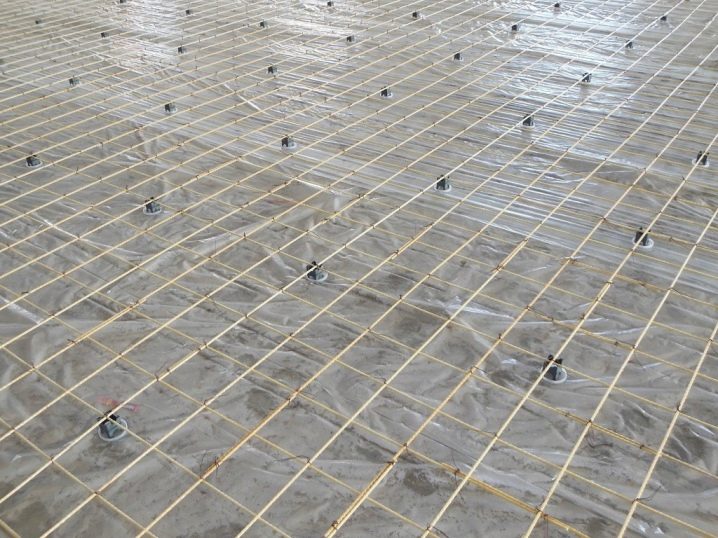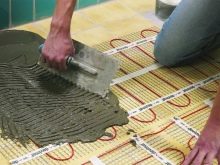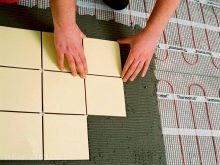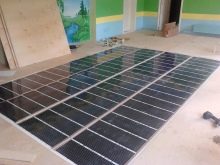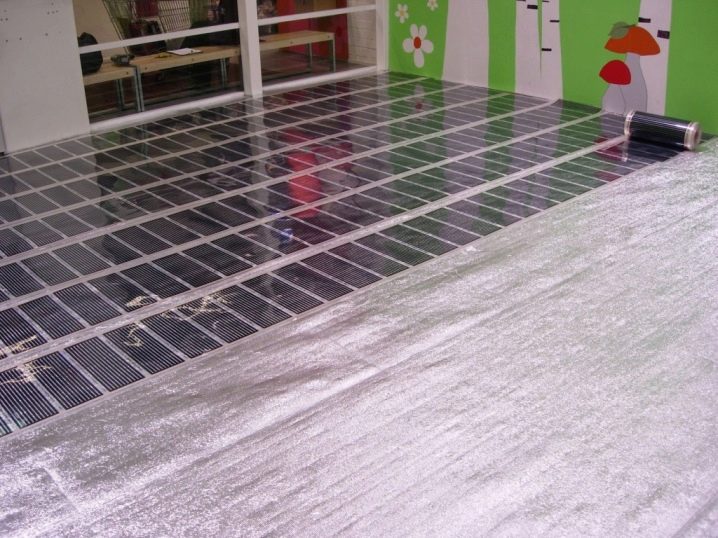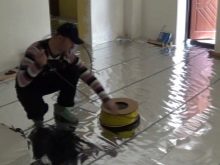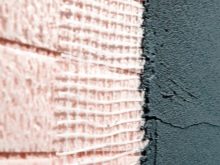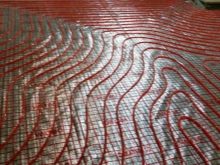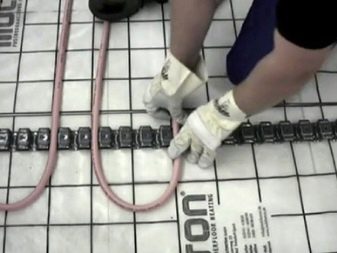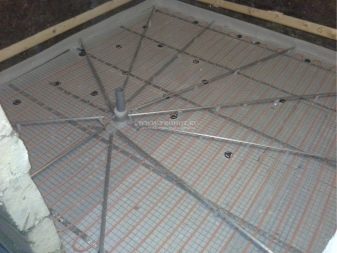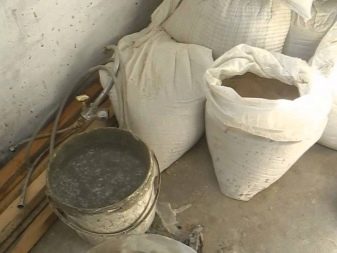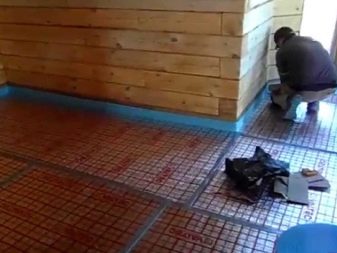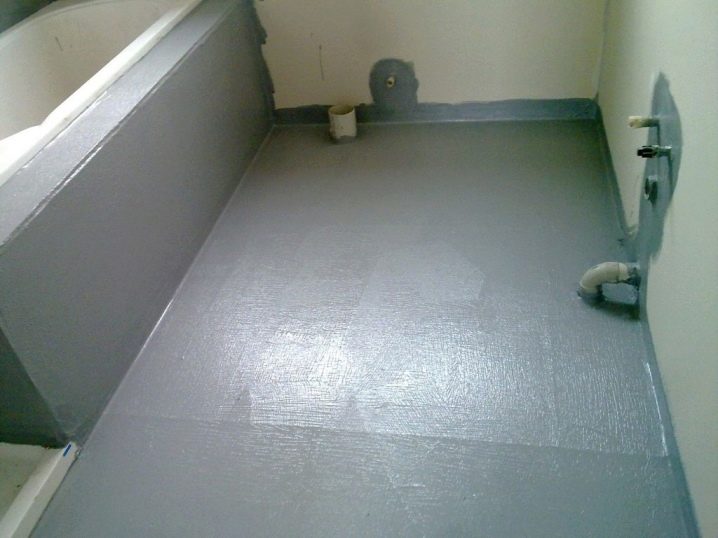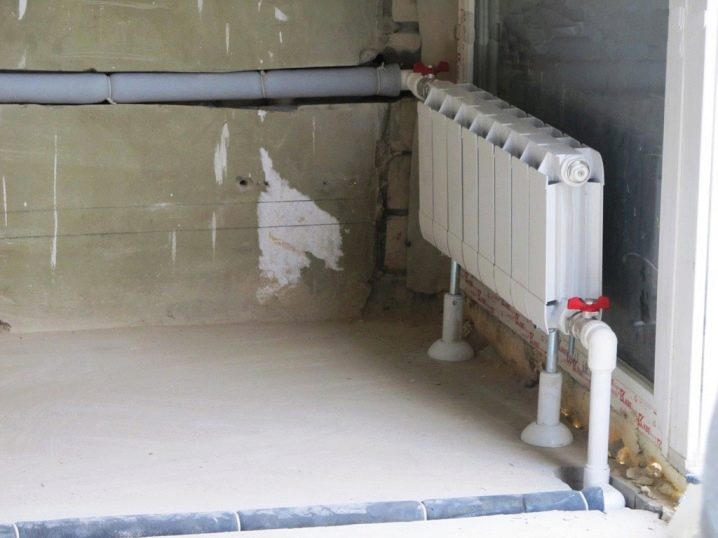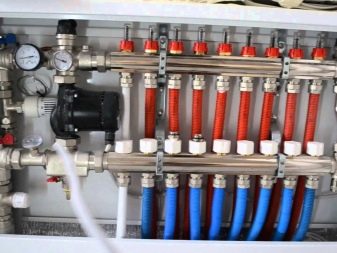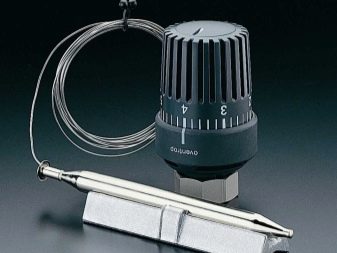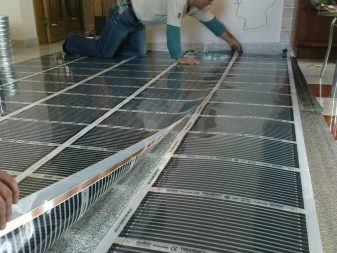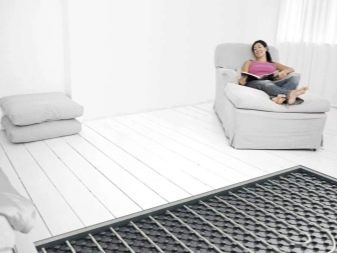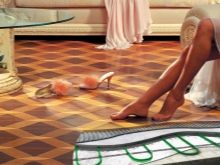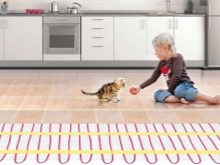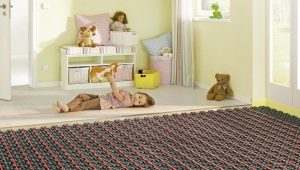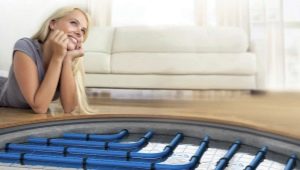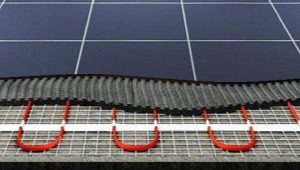Warm floor in the screed: the pros and cons
The difference of warm floors from other types of space heating is the presence of heating elements under the floor covering. This type of heating allows you to get rid of radiators on the walls, which need to be placed two or more in each room, and gives uniform heating throughout the room if the floor is settled in a private house.
Special features
Owners of their own homes are not limited in the choice of heating method. It all depends only on what is more reasonable to use: gas or electricity. With water floors, water consumption is not counted, as it circulates in a closed loop.
With the right device warm floor on the first floor of the cottage you can not think about heating the second floor. Thanks to convection, the warm air rises and the heat spreads through all the rooms.
With proper planning of the house and properly equipped roof on the second floor, as a rule, it is also warm, as well as below, without additional heating devices.
The apartment is very nice in the winter to put on warm boots that warmed up at the front door, and in the summer to go barefoot into the bathroom, without flinching over the cold tile. In the premises of apartment buildings, warm floors usually warm up certain areas: at the front door, on the balcony, in the kitchen or in the bathroom.
Since in apartments, as usual, there is an element of the presence of neighbors below, water-heated floors can cause a lot of trouble if a leak suddenly appears. In addition, to agree on a water-heated floor in the apartment is almost impossible. Therefore, when choosing a floor heating system for apartment owners, the choice is made only between an infrared film coating and floors based on the use of mini mats - heating elements mounted on a fiberglass grid. You can also choose the option of concrete.
Kinds
Heat-insulated flooring in houses can be of two types and is divided according to the type of heating element:
- water heated floors;
- electric heated floors.
For electric heated floors use film and mini-mats.
Laying floors using mini-mats or water heating elements is almost the same.Its layout is not very complicated, and therefore it will not be difficult to perform. The film has its own characteristics because of its thickness, so the technology for arranging such a floor will be different. The main thing - to choose a quality composition.
What should be the thickness?
The thickness of the screed directly depends on the choice of the heating element and the initial state of the surface on which it will be laid.
In the absence of a strict horizon level, it will be necessary to make a rough tie. Its thickness depends on the deviation of the floor surface from the horizontal and is individual for each room. If the surface on which the heated floor is mounted has a slope, the heating elements will be at different distances from the surface of the finishing screed and the floor covering. The result will be uneven heating throughout the room and heat loss. It is clear that, if necessary, the rough tie increases the size of the so-called "cake" and the consumption of materials.
Below is the calculation of the thickness of the "cake" when the device water heated floor and the presence of a horizontal surface. The waterproofing film has a thickness measured by microns, so you should not take it into account.Polystyrene plates are used with a thickness of 60 mm (2x30) and more, depending on the climatic characteristics of the region of residence. Heat-insulated metallized material must be at least 3 mm, the mesh for reinforcement of the screed and fixing of heating elements - from 5 mm.
Given the overlap of one bar to another, it takes 10 mm. The diameter of the element itself varies from 16 to 25 mm, the minimum height of the beacon for the tie is 10 mm.
Based on these figures, the thinnest “cake” will be 102 mm thick, of which the coupler itself will take 46 mm. From operating experience, such a screed is thin for a water floor, and may collapse during operation. Therefore, many masters prefer to use instead of purchased 10-millimeter beacons Starting profiles for the installation of drywall dimensions of 27x28 mm - they are tougher and higher than standard beacons.
The thickness of the screed increases to 60 mm and can withstand any load.
The technology of laying mini-mats on fiberglass is different in that there is no need for a reinforcing metal base and a thick screed on top. In addition, extruded polystyrene plates can be used with a smaller thickness. Therefore, the minimum thickness of the “pie” will be 60 mm, and the screed itself will be 17 mm.
But this is acceptable only in the case of subsequent laying on its surface of floor ceramic tiles, which will provide additional rigidity to the floor. If you plan to floor in the form of linoleum or laminate, it is desirable to increase the tie to 25-30 mm, which is the maximum value. The proportions of the mixture are selected individually.
For film warm floors instead of finishing screed using plywood or OSB. Manufacturers claim that the screed is not necessary. Its advantage is much less inertia, since the heat loss from heating a thick screed will be less. True, the floor will also cool almost immediately after turning off the thermostat.
The advantage of infrared film floors is that they do not dry the air. When drafting the floor does not take into account the space in rooms where there will be furniture, standing in one place. Under cabinets, tables, sofas, the film is not laid in order to avoid their deformation. From the walls and heating devices there should be an indent of at least 20-30 cm.
Installation of film underfloor heating begins with the laying of heat-reflecting foam material, for which it is very important not to conduct current.After laying all the elements in accordance with the project, connecting the thermal sensor and thermostat to the film floor, you can lay the laminate without pouring screed. To waterproof and eliminate the ingress of moisture to the electrical contacts, you need to lay a PVC film before laying the floor covering. If you plan to lay tile, it is better to protect the elements of the floor or plywood or OSB, or cement-bonded chipboard. All connections can also be very tightly sealed.
Fill
Before starting to coat the screed, all necessary heat saving and heating elements should be mounted and checked.
For the installation of a water floor, a waterproofing film of PVC with a skid on the walls of the room is first laid on the draft screed or slab. Butt on it fit the plates of extruded polystyrene, which are fastened together with tape. On top is laid foamed heat-reflecting material with a metallized coating.
The reflective layer should be facing the inside of the room. On the basis of the resulting metal mesh with a cell from 5x5 to 10x10 mm.It is desirable to fix it on the heat-saving "cake" with dowel-brackets.
Heating elements - pipes through which hot water will circulate - are fixed on the grid with hose clamps. It is better to lay them with a snake or a snail - here it is important to observe the principle of one circuit.
The principle of a single circuit provides that the entire elements of heating the water floor without joints between pipes should be laid on each room. Otherwise, it is possible that the joint will disperse during operation and there will be a leak of water, which may render the system itself and the screed together with the floor covering inoperable. If the room is very large (more than 20 sq. M), then it is better to lay two circuits on it. The number of circuits will determine which collector must be selected for the operation of all circuits in the house.
After fixing the heating elements install beacons. To facilitate the work for this operation, you can use plaster on a plaster basis - with it it is easier to adjust the guides exactly to the horizon and at one level. In addition, it does not "float" and quickly hardens.
For the preparation of the solution for screed recommendations vary greatly.Each master has his own skills and experience. The main thing is that the mixture has high strength and is technologically advanced. In the building stores sold M150 (sand cement) and M300 (sand concrete).
Someone prefers to mix cement with sand on their own. In any case, it is desirable to add plasticizers and additives to the mixture to prevent cracking of the finished screed. You can add to the solution up to 15% of the mix for a self-leveling floor on the basis of gypsum with cement - this will give the opportunity to walk on the floor within 3-5 hours after pouring. In addition, cracks will form much less.
Microfiber is often used to reinforce the mixture. The plasticizer for the mixture can be purchased in finished form. It is important that it is not too much in the process of mixing. If the recommendations of the manufacturer are followed, then it will help to improve the homogeneity of the mixture and its strength properties.
In any case, do not forget about the damper tape. From the physics course everyone remembers that the bodies expand when heated. Therefore, the thermal gaps, which are formed after dismantling the damper, will not allow the finished screed to collapse.
To prevent cracks on the surface of the screed, there are several proven methods:
- Capacities filled with water are left in the room so that the evaporating moisture prevents the screed from drying out too quickly.
- The screed is covered with PVC film over the entire surface. The meaning is the same: slow drying.
- The coupler is performed in several stages, each layer should be no more than 20-25 mm. With greater thickness, the likelihood of cracks increases.
So, the material for the screed should be strong and ductile. Screenings also need to choose carefully. On the concrete screed it is necessary to do the maximum expansion.
Professional Tips
Arrangement of warm water floors in MKD apartments is not recommended. First of all, this is called a change in the central heating system of the MKD and is a gross violation of the Housing Code of the Russian Federation. The reason is not only that neighbors can be flooded from below. Unauthorized connection to heating towers or heated towel rails in the bathroom violates the temperature level of the coolant for each room in the MCD. In order for this not to happen, it will be necessary to dismantle one or all of the radiators in the apartment, otherwise the energy costs for heating may be increased.
The choice of a warm floor should be based not only on the desire to have it, but also on the possibility of raising the height of the floor. For an apartment with a ceiling height of 2.5 m, a thick tie can be problematic.
Before starting work, you need to calculate all the materials necessary for the repair. It is necessary to take into account the cost not only of the heating elements and the heat insulating layer, but also such necessary devices, as water floor collectors, thermostats, thermostats and other mounting elements.
Be sure to use personal protective methods in the form of respirators and gloves.
You can not get to work without a ready, well-calculated project.
It is necessary to connect heating elements without joints, to which then it will be impossible to reach without dismantling the entire floor covering and screed.
The use of components from different manufacturers is not recommended - this can lead to depressurization of the system in a very short time. If the surface is cracked, it is quite difficult to repair it.
The power consumed by an electric floor heating can be very high.Therefore, it is necessary to lay a separate cable with a dedicated machine, and even better to provide an RCD.
When installing an electric floor heating it should be remembered that its elements should not intersect in any case. Installation of the temperature sensor should be carried out in the coldest place of the heated room. If the wire of the thermal sensor does not allow to do this, it is necessary to focus on its length, while it is impossible to increase it. All contacts must be insulated with bitumen tape tightly at the top and bottom.
Moist mixture must be watered with plain water. All irregularities need to be carefully repaired, so that in the future there is a good warming up of the surface.
Before planning a warm floor, it is useful to consult with those who have it already mounted. Based on experience, it can be added that more than half of the people who have invested their money in this pleasure do not use it.
A master class on screed for underfloor heating - in the next video.
